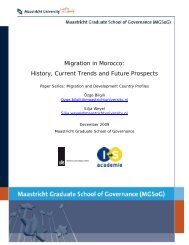Migration in Burundi: History, Current Trends and Future - MGSoG ...
Migration in Burundi: History, Current Trends and Future - MGSoG ...
Migration in Burundi: History, Current Trends and Future - MGSoG ...
You also want an ePaper? Increase the reach of your titles
YUMPU automatically turns print PDFs into web optimized ePapers that Google loves.
largely dependent upon the figures provided by relevant agencies <strong>in</strong> the host countries. It<br />
would moreover be imperative to differentiate between those who are <strong>in</strong>ternally<br />
displaced, those who crossed the borders as refugees (estimated <strong>in</strong> 2009 at 281,592 by<br />
UNHCR), <strong>and</strong> those who have sought asylum <strong>in</strong> Europe <strong>and</strong> North America. The three<br />
categories make up the <strong>Burundi</strong> diaspora even though some may be closer to the home<br />
country. These categories are also embedded <strong>in</strong> the broader description of the migration<br />
patterns <strong>in</strong> <strong>Burundi</strong>, which <strong>in</strong>clude <strong>in</strong>ternal versus <strong>in</strong>ternational, permanent versus<br />
circular, regular versus irregular, <strong>and</strong> voluntary versus forced migration (See IOM, 2008).<br />
The complexity <strong>in</strong>herent to the differentiation <strong>and</strong> categorization of <strong>Burundi</strong>ans<br />
liv<strong>in</strong>g outside their country has implications for the overall use of the term diaspora to<br />
refer to <strong>Burundi</strong>ans abroad. For the purpose of this paper, <strong>Burundi</strong>an diaspora is used to<br />
refer to all <strong>Burundi</strong>ans liv<strong>in</strong>g outside the country as refugees, temporary residents,<br />
permanent residents, or naturalised citizens of other countries. This broad def<strong>in</strong>ition is<br />
<strong>in</strong>formed by the fact that <strong>Burundi</strong>an diaspora has evolved over time <strong>and</strong> moved from<br />
one state of be<strong>in</strong>g abroad to another, especially as refugees who later become permanent<br />
residents or naturalised citizens of their adopted countries. Some of these migration<br />
processes began with <strong>in</strong>ternal displacement with<strong>in</strong> <strong>Burundi</strong>, followed by movement <strong>in</strong>to<br />
neighbour<strong>in</strong>g countries <strong>and</strong> later to Europe <strong>and</strong> North America (IOM, 2005). In addition<br />
to its own <strong>in</strong>ternally-displaced population (estimated at 100,000 people), <strong>Burundi</strong> is also<br />
host to large numbers of refugees from other countries with<strong>in</strong> the Great Lakes region,<br />
notably 9,849 from the Democratic Republic of the Congo (DRC) 10 The mass<br />
dislocations <strong>in</strong> <strong>Burundi</strong> are due to <strong>in</strong>ter-ethnic conflict <strong>and</strong> armed conflict between<br />
government <strong>and</strong> rebel forces <strong>in</strong> the north <strong>and</strong> western parts of the country 11 (also see<br />
IDMC, 2009).<br />
10 UNHCR, http://www.unhcr.org/cgi-b<strong>in</strong>/texis/vtx/page?page=49e45c056<br />
11 Interview, 26/11/2009. Accord<strong>in</strong>g to Bennett (1999, p27), displacements <strong>in</strong> <strong>Burundi</strong> are characterized by<br />
“forced relocation or re-groupment of entire communities, usually by a government, to permanent or semipermanent<br />
sites often directly or <strong>in</strong>directly under the control of military units”<br />
32



